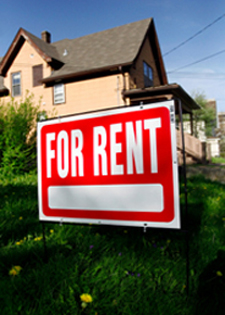Posted by Teresa on April 10, 2010 under Housing Trends, Landlord and Tenant FAQs, Landlord Tips | 
 In 2007, the U.S. Census Bureau reported 62% of U.S. households used the Internet in their home. That’s an enormous increase from 18% in 1997, the first year Internet use was tracked. 82% of those users reported having high-speed access, and 17% reported use of a dial-up connection. By October, 2009, some reports stated that Internet-using households in the U.S. increased to 69%.
In 2007, the U.S. Census Bureau reported 62% of U.S. households used the Internet in their home. That’s an enormous increase from 18% in 1997, the first year Internet use was tracked. 82% of those users reported having high-speed access, and 17% reported use of a dial-up connection. By October, 2009, some reports stated that Internet-using households in the U.S. increased to 69%.
It’s clear that the majority of American households use the Internet. And, the majority of those users have high-speed access. Demand has been overwhelmingly established. The only question is who pays for it?
Free Internet service is a common tenant perk. In some areas, it’s a given that a rental condo or apartment will come with free Internet—even though it might be bundled into the rent. In other markets, tenants are expected to pay for all of their utilities themselves—including Internet service.
And even though the first quarter apartment rent report showed promising results in some markets, things are still tough in the rental property business. Plenty of competition means owners continue to create incentives to attract good tenants. Is providing Internet service a good move?
Look at your market. Survey Craigslist.org and other online listing services for rental housing offers in your category. If the majority of single-family rentals do not brag about free Internet, you might need to provide it in yours. But, if you own an apartment building near your local college campus, and everyone else in the For Rent category is offering free Internet, you might have just found the reason your rentals are not filling up fast enough.
Check with your local Internet service provider about the cost of wireless service. Modem leases and monthly charges vary. Ask about security, too—especially if you have a duplex or multi-family housing situation. You don’t want a situation where tenants are vulnerable to stolen information—and you don’t want to provide free Internet to the entire neighborhood! Your ISP should be able to set up a secure system for your rental units quickly.
Whether you pass the cost along to your tenants or not probably depends on the cost, right? Still, hearing “free Internet” might be the tipping point that makes a potential tenant a year-long lease-signing tenant. And if you’re in need of some more of those, you might want to at least consider providing free Internet.
Posted by Teresa on April 6, 2010 under General | 
 U.S. apartment rents rose from the fourth quarter of 2009 to the first quarter of 2010, by a tiny 0.1% for asking rents and 0.3% for effective rents. This is the first quarterly effective rent increase since the third quarter of 2008, according to a Reis, Inc. report released today. When effective rents (which include perks like free rent and utilities) increase, it suggests that landlords are actually making fewer concessions to tenants—and they are paying off.
U.S. apartment rents rose from the fourth quarter of 2009 to the first quarter of 2010, by a tiny 0.1% for asking rents and 0.3% for effective rents. This is the first quarterly effective rent increase since the third quarter of 2008, according to a Reis, Inc. report released today. When effective rents (which include perks like free rent and utilities) increase, it suggests that landlords are actually making fewer concessions to tenants—and they are paying off.
While effective rent was up from the previous quarter, it was still down 2.3% compared to the first quarter of 2009. However, that’s much better than the 5.6% decline we saw from 2008’s to 2009’s first quarter. This dramatic change indicates a reversal in rent decreases.
Strong markets that saw rent increases include Miami, New York City (the most competitive apartment market in the U.S.), Colorado Springs, Washington, DC, San Antonio, and Dayton, OH. Continued struggles were seen with lowered year-over-year rents in Las Vegas, San Jose, and San Francisco.
In Miami, effective rents for the first quarter gained 1.6% to $1,008 per month, and in New York, the gain was 0.9%, to $2,667 per month.
Vacancy rates remained unchanged—at the record level of 8%—during the first quarter. However, no increase can a sign the market is at or approaching the bottom of the vacancy pit and recovery is on the horizon. In New York City, vacancies even fell 0.1% to 2.8% from the previous quarter.
What about new construction? Well, 22,000 new apartment units opened in 2010’s first quarter, and their vacancy rate was a whopping 52.8%. And in 30 of the 79 markets studied, vacancies rose. But large investors are again looking at developing apartment properties—perhaps anticipating increased demand for next year.
Looking at the overall 1st quarter picture, it’s much brighter than reports were throughout 2009, so it’s possible that the apartment market will be on its way to recovery this year—as long as the economy picks up some steam, and some jobs.
Pre-screen all tenants as part of your standard application process. Background and credit checks will help ensure you rent to qualified tenants. For more landlord resources, including forms and information on tenant screening, turn to E-Renter.com.
Posted by Teresa on January 7, 2010 under Housing Trends, Rental Market | 
Reis, Inc., a real estate research firm just released its 4th Quarter 2009 apartment vacancy report. As expected, it hit 8%—the highest in thirty years. The poor state of the U.S. job market continues to be blamed, as job creation lags behind other positive economic indicators. Young people, who are typically apartment renters, have been hit especially hard in the job market.
A bit more positive is the news that an ever-increasing supply of newly built apartment units is starting to decline—finally catching up with the credit crunch that began in the summer of 2008. 28,000 new apartments came onto the market in the 4th quarter 2009. The total for the year: 120,000, including developments intended for condos that converted to rentals. New apartment supply should fall by half in 2011, and if jobs improve, there could be some rental market recovery by the middle of this year, according to the report.
The U.S. apartment vacancy rate rose .10 percent from the 3rd quarter, and 1.3 percent for the year, ending at 8%. Sunbelt cities like Tucson AZ, and Jacksonville, FL experienced huge vacancy increases in 2009, at 10.5% and 14.4%, respectively. Charlotte, NC and Lexington, KY were also hit hard. Nationwide, vacancies increased in 52 markets, improved in 17, and remained flat in 10.
Not only are vacancies higher than ever, but landlords are experiencing a double-whammy: both asking and effective rents are plummeting. For 2009, asking rents fell 2.3%, also the largest decrease in thirty years; effective rent fell .7% to $964 per square foot.
And while mortgage financing has toughened up, government efforts to enhance the housing market threaten apartment owners, as some renters find it easier to buy a home. In some markets, continued unrest in the housing sector and lower rents will make renting more attractive than buying.
Landlords and rental property owners will likely need to continue offering rent reductions, perks and amenities to entice new tenants—until the job market improves. And when that will happen is anybody’s guess.
 Reis, Inc., a real estate research firm just released its 4th Quarter 2009 apartment vacancy report. As expected, vacancies hit 8%—the highest in thirty years. The poor state of the U.S. job market continues to be blamed, as job creation lags behind other positive economic indicators. Young people, who are typically apartment renters, have been hit especially hard in the job market.
Reis, Inc., a real estate research firm just released its 4th Quarter 2009 apartment vacancy report. As expected, vacancies hit 8%—the highest in thirty years. The poor state of the U.S. job market continues to be blamed, as job creation lags behind other positive economic indicators. Young people, who are typically apartment renters, have been hit especially hard in the job market.
A bit more positive is the news that an ever-increasing supply of newly built apartment units is starting to decline—finally catching up with the credit crunch that began in the summer of 2008. 28,000 new apartments came onto the market in the 4th quarter 2009. The total for the year: 120,000, including developments intended for condos that converted to rentals. New apartment supply should fall by half in 2011, and if jobs improve, there could be some rental market recovery by the middle of this year, according to the report.
The U.S. apartment vacancy rate rose .20 percent from the 3rd quarter, and 1.3 percent for the year, ending at 8%. Sunbelt cities like Tucson AZ, and Jacksonville, FL experienced huge vacancy increases in 2009, at 10.5% and 14.4%, respectively. Charlotte, NC and Lexington, KY were also hit hard. Nationwide, vacancies increased in 52 markets, improved in 17, and remained flat in 10.
Not only are vacancies higher than ever, but landlords are experiencing a double-whammy: both asking and effective rents are plummeting. For 2009, asking rents fell 2.3%, also the largest decrease in thirty years; effective rent fell .7% to $964 per square foot.
And while mortgage financing has toughened up, government efforts to enhance the housing market threaten apartment owners, as some renters find it easier to buy a home. In some markets, continued unrest in the housing sector and lower rents will make renting more attractive than buying.
Landlords and rental property owners will likely need to continue offering rent reductions, perks and amenities to entice new tenants—until the job market improves. And when that will happen is anybody’s guess.
Posted by Teresa on November 13, 2009 under General | 
 Are you a landlord who routinely offers year-long leases? Are troubling times and less-than-stellar tenant credit checks making you uneasy about continuing to do so?
Are you a landlord who routinely offers year-long leases? Are troubling times and less-than-stellar tenant credit checks making you uneasy about continuing to do so?
A flexible approach helps in an uncertain rental climate. Now is the perfect time to rethink your procedures, especially if they aren’t working for you as they once did.
Take leases, for instance. While a one-year lease might be ideal in a perfect rental world—where tenants have stellar credit, rents are where they should be, and competition is low—they may not work to your advantage now. While it’s reassuring to know a tenant is obligated to rent from you for a year, it can make you nervous to think of a sketchy client on your property for that long. Things could get complicated.
In tough economic times, incomes are lower due to job losses; evictions are more common; and credit reports are poorer. These factors, plus a one-year commitment, equal one risky situation. But you can mitigate your risk. As landlord, you get to decide how long the lease term is. If, after you’ve conducted proper tenant screening, a one year lease seems risky, consider offering a six month or month-to-month lease.
Only you can decide if it’s better to face empty rental units or offer a short-term lease to an applicant you might have passed on before. But you’re in control and you do have options, which can make it easier to weather a downturn in the rental market.
Posted by Teresa on November 5, 2009 under Housing Trends | 
 Where are all the tenants? Some are moving back home with mom and dad. Or returning to school and living with relatives. Others took in roommates to help pay the rent, or are staying with friends temporarily.
Where are all the tenants? Some are moving back home with mom and dad. Or returning to school and living with relatives. Others took in roommates to help pay the rent, or are staying with friends temporarily.
These are some of the reasons tenants are out of the rental market, causing the U.S. apartment vacancy rate to rise to 7.8% in the 3rd quarter. This 23-year high occurred despite landlords nationwide lowering rents. Reis, Inc., a real estate research firm that published the vacancy report, stated that the peak has not yet been reached; they expect the number to climb above 8% in the coming months.
Nervous landlords are looking toward the traditionally slow 4th quarter with little hope for improvement, which is expected sometime in 2010—perhaps as soon as the second quarter.
While vacancies increased, rents have declined for four quarters in a row—which may have kept the vacancy rate from soaring even higher. Landlords have responded quickly to market conditions, including over supply, and lowered rents to keep tenants. Rents are expected to stay soft for at least another year.
Oversupply will continue to be a contributing factor to the vacancy problem. 73,000 apartment units have come on the market in the first three quarters of 2009, and 42% of them remain vacant, according to Reis. The bright spot is that new apartment construction has slowed down to a trickle, so eventually, demand will catch up to supply.
As unemployment hovers near 10% nationwide, and benefits start running out, rent money is disappearing, too. Simply put, folks with no rent money cannot be tenants. Landlords will need to continue aggressively seeking out new tenants to fill vacancies, offer incentives to good tenants to get them to stay, and hold on until the job market improves—when there are more people with money to spend on housing.
Especially in a down economy, we recommend you
screen all tenants as part of your application process. For more landlord resources, including forms and information on
tenant screening, turn to
E-Renter.com. .
 In 2007, the U.S. Census Bureau reported 62% of U.S. households used the Internet in their home. That’s an enormous increase from 18% in 1997, the first year Internet use was tracked. 82% of those users reported having high-speed access, and 17% reported use of a dial-up connection. By October, 2009, some reports stated that Internet-using households in the U.S. increased to 69%.
In 2007, the U.S. Census Bureau reported 62% of U.S. households used the Internet in their home. That’s an enormous increase from 18% in 1997, the first year Internet use was tracked. 82% of those users reported having high-speed access, and 17% reported use of a dial-up connection. By October, 2009, some reports stated that Internet-using households in the U.S. increased to 69%.



